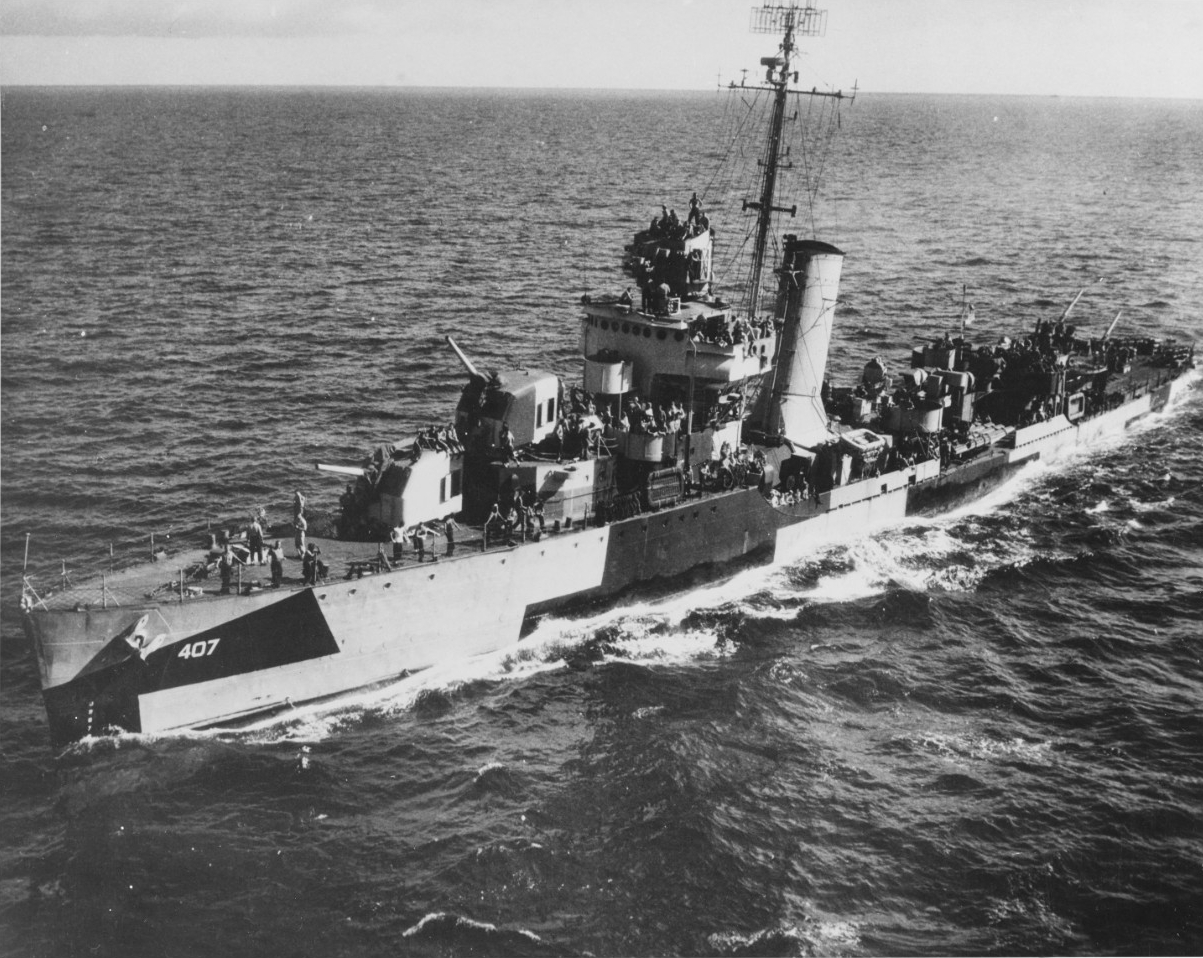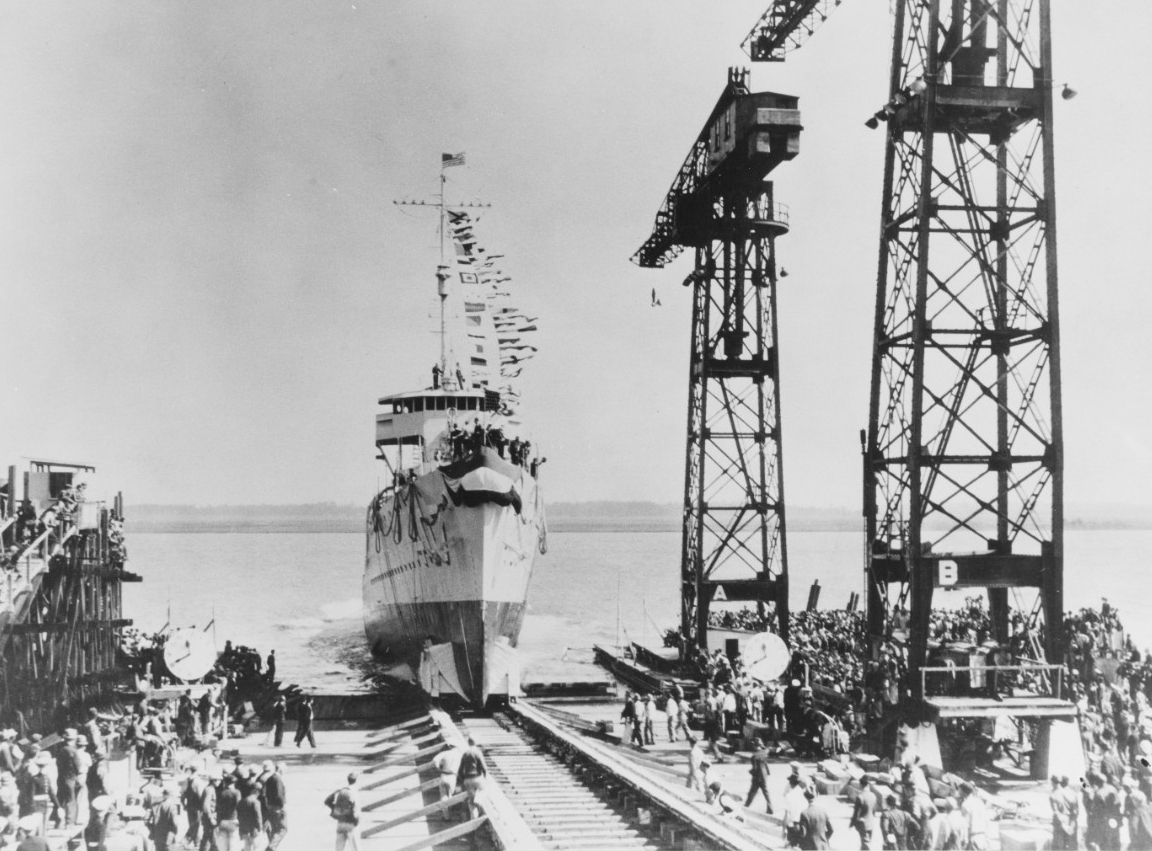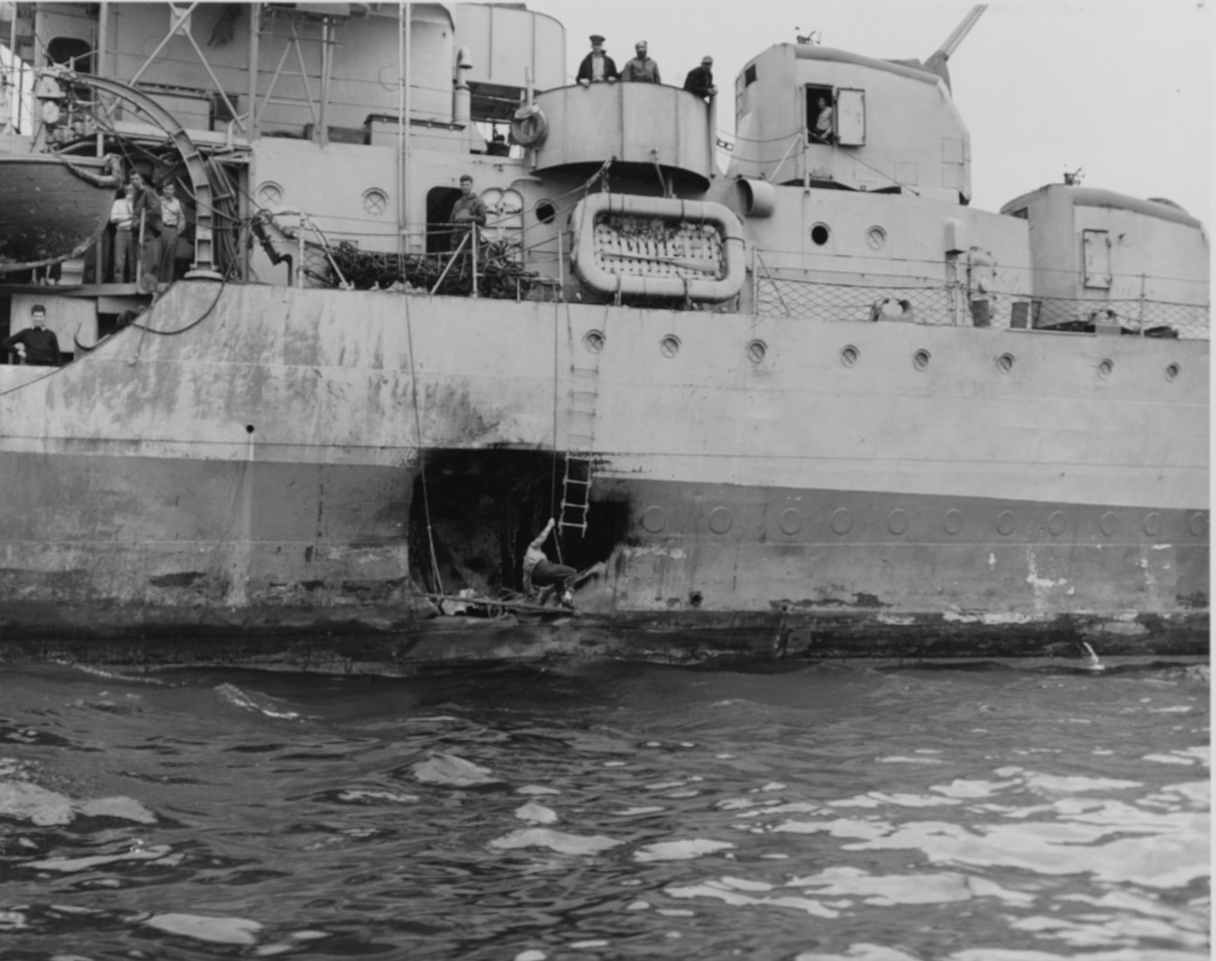Sterett II (DD-407)
Andrew Sterett, born in 1760 in Baltimore, Md., was appointed lieutenant in the United States Navy on 25 March 1798 and assigned to Constellation as Third Lieutenant. During the Quasi-War with France, he was still serving in Constellation when she captured L'lnsurgente. By 1800, he had risen to First Lieutenant; and he participated in Constellation's action against La Vengeance.
Given command of the schooner, Enterprise, Lt. Sterett led her in the capture of the French privateer, V'Amour de la Patrie, on Christmas Eve 1800. In June 1801, he sailed in Enterprise from Baltimore for service with the Mediterranean Squadron. While on that cruise, Enterprise engaged and captured a 14-gun Tripolitan cruiser and her 80-man crew. In gratitude, Congress awarded Sterett a sword and highly commended his crew. Lt. Sterett continued his Navy career until he resigned his commission in 1805. He died on 9 June 1807, at Lima, Peru.
II
The second Sterett (DD-407) was laid down on 2 December 1936 at the Charleston Navy Yard; launched on 27 October 1938; sponsored by Mrs. Camilla Ridgely Simpson; and commissioned on 15 August 1939, Lt. Comdr. Atherton Macondray in command.
Sterett departed Charleston on 28 October 1939 in company with two other newly-commissioned destroyers, Mustin (DD-413) and Hughes (DD-410), for shakedown in the Gulf of Mexico. She visited Vera Cruz, Cristobal, Mobile, and Guantanamo Bay before returning to Charleston on 20 December. She underwent post-shakedown overhaul and trials at Charleston until departing on 4 May 1940. Assigned to Destroyer Division 15, Sterett rendevoused with Hammann (DD-412) at Guantanamo Bay, and the two destroyers steamed for San Diego, via the Panama Canal. They arrived in San Diego on 23 May; and, for a month, Sterett divided her time between training and plane-guarding Enterprise (CV-6). On 24 June, she sailed for Hawaii with Enterprise and five other destroyers, and arrived at Pearl Harbor on 2 July.
She operated out of Pearl Harbor for the next 10 months, participating in a number of exercises and patrols. When Mississippi (BB-11) exited Pearl Harbor on 14 May 1941, Sterett was in her screen. The warships transited the Panama Canal and arrived at Norfolk on 28 June. Sterett next screened Long Island (CVE-1) during the escort carrier's Bermuda shakedown cruise. Sterett concluded 1941 engaged in neutrality patrols with Wasp (CV-7). After the Japanese attacked the Pacific Fleet at Pearl Harbor, Sterett sailed from Bermuda with Wasp and an assortment of cruisers and destroyers to counter possible action by Vichy French ships anchored at Martinique.
Sterett spent the early months of the war patrolling off the eastern seaboard. In mid-January, she sailed to Argentia, Newfoundland, to meet Task Force (TF) 15 and escort a convoy to Iceland. The convoy was transferred to two British destroyers on 23 January 1942, and she put into Hvalfjordur, Iceland, on the 26th. Sterett returned to the United States at New York on 9 February and stood out again on the 15th to meet the liner Queen Mary off the Boston breakwater and escort her into the harbor. After two trips between Boston and Casco Bay, Maine, Sterett joined Wasp as part of her escort to duty with the British Home Fleet. The task group entered Scapa Flow, Orkney Islands, on 4 April minus its commanding officer, Rear Admiral John W. Wilcox, who was lost overboard during the passage.
While Wasp made her first aerial reinforcement of embattled Malta, Sterett trained with the British Fleet out of Scapa Flow. The destroyer was with Wasp on her second run to Malta, 29 April to 15 May, and, after returning to Scapa Flow, headed for the United States. The task group made Norfolk on 27 May 1942. On 5 June, Sterett put to sea bound for San Diego, where she arrived on 19 June. She stood out again on 1 July and, as a part of TF 18, steamed, via Tongatabu, to the Fiji Islands. She was assimilated into Rear Adm. Richmond K. Turner's South Pacific Amphibious Expeditionary Force and practiced invasion techniques at Fiji until 1 August.
Sterett spent the rest of 1942 and all of 1943 supporting the Allied forces as they struggled up the island staircase formed by the Solomons Islands and the Bismarck Archipelago. The Solomons invasion fleet, guarded by three carrier task groups led by Saratoga (CV-3), Enterprise, and Wasp, arrived in the Solomons late on 6 August. Early the next morning, the carriers catapulted their planes into the air for strikes on enemy installations and troop concentrations; and, afterward, the fleet softened the beaches with its big guns. As this overture neared its end, the Marines stormed ashore at Guadalcanal, Gavutu, Tulagi, and Tanambogo. Meanwhile, Sterett and the Wasp carrier group zigzagged into a rain squall, successfully dodging an 18-plane raid launched from Rabaul on New Britain.
For the next three days, the Wasp unit guarded the supply lines to Tulagi. From there, Sterett sailed east of San Cristobal to screen Long Island while she launched 31 Marine planes for use on Guadalcanal. Rejoining Wasp immediately, Sterett remained with her until DesDiv 15 was detached on 10 September 1942. Five days later, the carrier, Sterett's long-standing companion, was at the bottom of the Pacific.
For the next month, Sterett escorted convoys and reinforcements to the Solomons and between the islands of that group, splashing at least one Japanese bomber. Following duty escorting Bellatrix (AK-20) and Betelgeuse (AK-28) to Espiritu Santo in the New Hebrides and guarding the latter all the way to Noumea, New Caledonia, she returned to Guadalcanal accompanying two transports, McCawley (AP-10) and Zeilen (AP-9), loaded with troops and equipment. While the transports unloaded, Sterett fired on enemy bombers and shore batteries harassing Henderson Field on Guadalcanal.
The destroyer returned to the New Hebrides and, after refueling, put to sea on 31 October to protect still more reinforcements to Guadalcanal. The convoy arrived at Aola Bay early on 4 November. Sterett covered the establishment of the beachhead and later joined San Francisco (CA-38) and Helena (CL-50) in a bombardment of Japanese positions near Koli Point. Two days later, she retired to Espiritu Santo.
There, she met another convoy and escorted it to Lunga Point, Guadalcanal. As the troops were landing on the morning of the 12th, Sterett took up station to meet expected air raids. Just after noon, she received word that a large flock of Japanese planes had been spotted by a coastwatcher on Buin. In less than an hour, the attackers swooped in low against the dark background of Tulagi and Florida islands. Sterett, directly in the line of the enemy's approach, shot down four torpedo bombers while dodging at least three torpedoes. By 1450, 32 of the attackers were splashed by antiaircraft fire and American aircraft. The remainder retreated. The transports resumed their unloading, and Sterett enjoyed relative quiet for the rest of the day.
That evening, after shepherding the transports east to safety, Sterett joined the van of the cruiser-destroyer force under the command of Rear Admiral Callaghan and steamed back through Lengo Channel to intercept Vice Admiral Hiroaki Abe's raiding force. Sterett and her colleagues in the van, followed by five cruisers and a rearguard of four more destroyers, passed Lunga Point abeam, increased speed and, upon reaching a point about three miles north of Tassafa-ronga, changed course. As the warships sped toward Savo Island, their radar screens were dotted by echoes from the enemy ships. Helena reported first contact at 0130 on the 13th, and soon all American ships were receiving reflections from the Japanese ships. The two forces were closing each other at a combined speed in excess of 40 knots.
The American warships threaded their way into the enemy formation, and a deadly crossfire immediately engulfed Sterett. At 0150, Admiral Callaghan ordered odd ships in column to open fire to starboard and even ships to engage the enemy to port. Sterett fired on a cruiser to starboard and, in turn, took a terrific pounding from battleship Hiei on her port side. Soon her first target was enveloped in a large explosion and sank, a victim of the combined fire of the Americans.
At this point, the battle degenerated into a swirl of individual duels and passing shots. Sterett turned now to the giant tormenting her port side, let fly four torpedoes, and peppered her superstructure with 5-inch shells. Though the battleship neither sank nor sustained severe damage, Sterett had the satisfaction of scoring two torpedo hits before a third target crossed her bow. At the appearance of an enemy more her size, Sterett tore into the destroyer with her guns and launched two torpedoes. Before the Japanese destroyer could fire a single shot at Sterett, she was lifted from the water by the exploding torpedoes and rapidly settled to the floor of "Iron-bottom Sound."
By this time, Sterett had undergone a brutal beating from Hiei and various other enemy ships. Thus, at 0230, with the Japanese retiring toward Savo Island, Sterett, her after guns and starboard torpedo tubes out of commission, began to withdraw. She had difficulty overtaking the rest of her force because of her damaged steering gear and the necessity to reduce speed periodically to control the blaze on her after deck. However, by dawn, she was back in formation on the starboard quarter of San Francisco.
Before heading for Espiritu Santo on the 13th, she delivered her parting shot to the enemy by depth-charging a sound contact, possibly the submarine which, about an hour later, would sink Juneau (CL-52). Sterett arrived in the New Hebrides on 14 November, underwent emergency repairs, and departed from Espiritu Santo 10 days later. Visiting Pearl Harbor along the way, she steamed into San Francisco Bay and entered Mare Island Naval Shipyard, where she remained for two months. Sterett set sail from San Francisco on 10 February 1943, joined Nassau (CVE-16) at Pearl Harbor, and together they entered Espiritu Santo on 8 March. Upon her return to the Pacific theater, Sterett resumed her original assignment: guarding convoys to the Solomons-Bismarcks area and patrolling the area to prevent enemy reinforcements from being moved into the fray.
On 6 August 1943, Sterett was cruising "Iron-bottom Sound" in the second division of the six-destroyer task group under Comdr. Frederick Moosbrugger. At 1200, air reconnaissance reported an enemy force of four destroyers delivering troops and supplies to Kolombangara via Vella Gulf. At dusk, the six Americans passed cautiously through Gizo Strait into Vella Gulf. By midnight, the two divisions were skirting the coast of Kolombangara about two miles apart. Radar picked up the Japanese ships heading south at about 30 knots. One division launched eight torpedoes at the Japanese column's port side; then Sterett's division loosed their torpedoes and opened with their guns. Three of the four enemy destroyers took torpedo hits and received the coup de grace from 5-inch guns. Shigure, the lone survivor, retreated at high speed to Buin. At Vella Gulf, Sterett and her comrades accounted for three enemy destroyers, over 1,500 sailors and soldiers, and a large portion of the 50 tons of supplies.
For the rest of August and throughout September, Sterett occupied herself with patrols in the Solomons. On 8 October, she arrived in Sydney, Australia, escorting Cleveland (CL-55). The two warships reached Espiritu Santo on the 24th. At the beginning of November, she accompanied the assault forces to Bougainville, Solomon Islands; and, between 5 and 11 November, supported the carriers while their planes bombed Japanese ships at Rabaul. She screened the carriers who delivered the 9 December raid on Nauru Island; then withdrew to the New Hebrides until 27 December. In the Solomons on the last three days of 1943, Sterett escorted Alabama (BB-60) to Pearl Harbor and on to the Ellice Islands, arriving at Funafuti on 21 January 1944. Two days afterward, she put to sea with Bunker Hill (CV-17) and Monterey (CVL-26).
From 29 January to 7 March 1944, Sterett operated in the Marianas and Marshalls. On the 29th, her carriers' planes struck Roi and Namur islands of Kwajalein Atoll. Next came the 12 February raid on Truk. Five days later, Sterett covered the flattops during raids on Tinian and Saipan. She departed the Marshalls for the New Hebrides, where she joined the Emirau invasion force. Sterett stopped at Purvis Bay, Florida Island, on 4 April and visited Efate on 7 April during her voyage from Emirau Island to the United States.
Sterett stopped at Pearl Harbor on 16 and 17 April and arrived at the Puget Sound Navy Yard on the 29th. She underwent yard work from 24 to 30 April and then moved down the coast on 3 May to San Francisco Bay. Forty-eight hours later, she sailed out for Oahu and reached Pearl Harbor on the 10th. Following 14 days of exercises in the Hawaiian Islands, she sortied with TG 12.1 for the Marshalls. At Majuro from 30 May, she exited the lagoon with TF 58 on 6 June to screen the support carriers during the invasion of the Marianas. Sterett cruised with the carriers from 11 to 25 June as they launched and recovered wave after wave of planes for strikes on Saipan, Iwo Jima, Guam, and Rota Islands, periodically fending off Japanese aerial retaliation.
From 25 June until 7 July, she patrolled the waters around Guam and Rota and bombarded Guam. After covering the carriers during the sweeps over Yap, Palau, and Ulithi, she sailed for Eniwetok en route to Puget Sound. She stopped at Pearl Harbor from 10 to 14 August and headed on to Bremerton, Wash., entering the Puget Sound Navy Yard on the 20th. Completing overhaul and trials up and down the west coast, she sailed west on 13 October for the Hawaiian Islands. Sterett sortied from Oahu with TU 16.8.5 on 19 November and, 12 days later, entered Seeadler Harbor, Manus, Admiralty Islands. Two weeks before Christmas 1944, she entered Leyte Gulf in the Philippines for patrol and convoy duty.
On the day after Christmas, she started for Mindoro with a supply convoy. Two days later, the Japanese attacked. Early that morning, three kamikazis dove at Sterett's convoy. Antiaircraft fire splashed the first, but the second and third succeeded in crashing into merchantmen. Sterett endured the onslaught of the "Divine Wind" until the task unit was dissolved on New Year's Day 1945. On that date, she returned to San Pedro Bay, claiming the destruction of one enemy suicide plane for herself and assists in eliminating two others. During the next three months, Sterett plied the waters of the South and Central Pacific, primarily engaged in patrol and convoy duty in the Solomons.
By 1 April 1945, she was off Okinawa, taking part in the conquest of the Ryukyus as a radar picket ship. At Okinawa, Japan hurled a storm of suicide planes at the Navy. Particularly hard-hit were the ships on radar picket duty. On 6 April, Sterett had to accompany her companion ship, Bennett (DD-473), to Zampa Misaki on Okinawa after that destroyer had been hit by a kamikaze.
Three days later, Sterett suffered the same fate. While at picket station #4 northeast of Okinawa, five enemy planes swooped on her, LCS-36, and LCS-24. The first was driven off and later downed; the second was splashed by the destroyer's main battery; but the third, though battered by her barrage, pressed home its attack and smashed into Sterett's starboard side at her waterline. She lost all electrical power, but her 20 millimeter and 40 millimeter guns still managed to bring down the fourth attacker. The destroyer lost steering and power to all guns and directors; her communications were out; and her forward fuel tanks were ruptured. However, with the fires in the mess hall under control, steering control reestablished aft, and emergency communication lines rigged, she moved off to Kerama Retto with Jeffers (DMS-27) providing antiaircraft cover.
Following emergency repairs at Kerama Retto, she screened TU 53.7.1 to Ulithi; and, from there, she and Rail (DE-304) sailed to Pearl Harbor. After spending the period from 1 to 10 May at Oahu, she moved on to Bremerton, Wash., and more extensive repairs. Through the months of June, July, and the first three weeks of August 1945, she remained on the west coast. Then, from 21 to 28 August, Sterett steamed to Pearl Harbor. Upon her arrival, she practiced shore bombardment and antiaircraft gunnery for a month. On 25 September, she set sail with Mississippi (BB-41), North Carolina (BB-55), and Enterprise (CV-6).
Sterett transited the Panama Canal on 8 and 9 October and, after a three-day stay in Coco Solo, C.Z., proceeded north. She arrived in New York on 17 October and was decommissioned there on 2 November 1945. Her name was struck from the Navy list on 25 February 1947, and she was sold on 10 August to Northern Metal Co. of Philadelphia for scrapping.
Sterett (DD-407) earned 12 battle stars and the Philippine Republic Presidential Unit Citation for World War II service.





